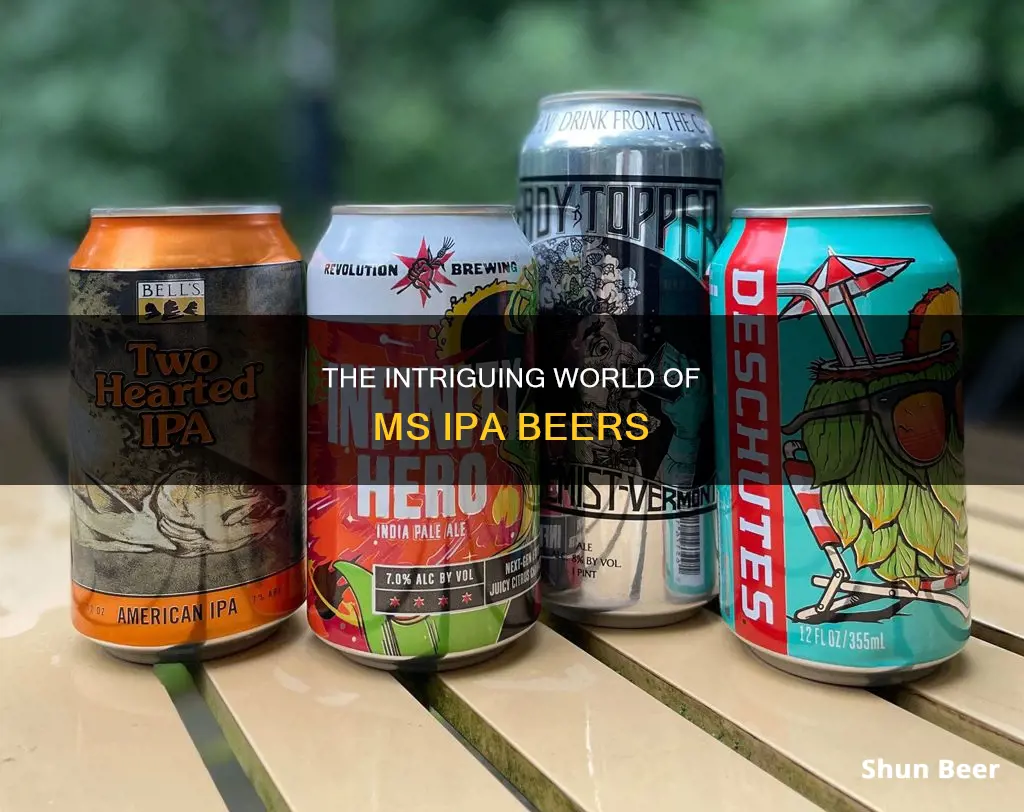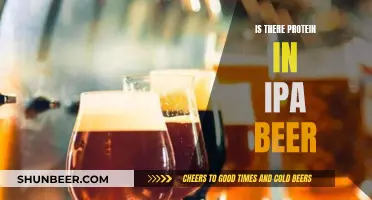
India Pale Ale, or IPA, is a hoppy beer style within the broader category of pale ale. The name comes from the beer's origins as an export beer shipped to India during British colonial times. The beer was brewed with lots of hops to survive long journeys without going bad. Today, IPAs are known for their bold, bitter, fruity, and floral flavours, with a higher ABV than traditional pale ales. They are also often high in carbs and calories. There are several types of IPAs, including West Coast, New England, Session, British, Double or Imperial, and Triple IPAs, each with unique characteristics and alcohol content.
| Characteristics | Values |
|---|---|
| Full Form | India Pale Ale or Indian Pale Ale |
| Origin | British sailors on long voyages to India needed a beer that could withstand the journey and the hot, humid temperatures |
| Flavour | Hoppy, fruity, bitter, malty, piney, citrusy, earthy |
| ABV | 5% or lower for session IPAs; 6-7% for modern American IPAs; 7% or higher for double/imperial IPAs; 10% or higher for triple IPAs |
| Calories | 170-240 per serving |
| Carbohydrates | Around 30 carbs per serving |
| Styles | Session, New England, West Coast, British, Double/Imperial, Triple, Black, Brut, East India, New England, Milkshake, Belgian, Fruited, Sour, Brett, White, India Pale Lager/Cold |

History of the IPA
India Pale Ale (IPA) is a hoppy beer that was originally an export beer shipped to India, which was under the control of the British East India Company until 1858. The beer was formulated to survive the long voyage from England to India better than other beer styles of the time.
Early IPAs
The pale ales of the early 18th century were lightly hopped and quite different from today's pale ales. By the mid-18th century, pale ale was brewed mostly with coke-fired malt, which produced less smoking and roasting of barley in the malting process, and hence produced a paler beer. One such variety of beer was October beer, a pale well-hopped brew popular among the landed gentry, which was brewed domestically and intended to be cellared for two years.
Among the first brewers known to export beer to India was George Hodgson's Bow Brewery, on the Middlesex-Essex boundary. Its beers became popular among East India Company traders in the late 18th century due to the brewery's proximity to the East India Docks and Hodgson's liberal credit line of 18 months. Ships exported this beer to India, among them his October beer, which benefited from the conditions of the voyage and was highly regarded by its consumers in India.
The growth of IPAs
Burton breweries, which had lost their export market in Continental Europe, including Scandinavia and Russia, due to the Napoleonic blockade, began seeking a new export market for their beer. At the behest of the East India Company, Allsopp's brewery's chief maltser, Job Goodhead, developed a strongly-hopped pale ale in the style of Hodgson's for export to India. Other Burton brewers, including Bass and Salt and Co, followed Allsopp's lead, taking advantage of Burton water in brewing similar beers.
By the early 19th century, "pale ale prepared for the India market" was gaining in popularity as exports increased, and by the 1830s, India pale ale became one of England's best-selling beers. The first known recorded mention of the phrase "India Pale Ale" came in 1835 in an edition of the Liverpool Mercury.
Decline and revival of IPAs
The popularity of India pale ales waned in England by the start of the 20th century as new styles entered the market, and commercial refrigeration made it easier to ship perishable goods. However, almost two centuries after the first IPA was brewed, Americans revived IPAs with the cultivation of a new type of hops, Cascade hops, released to the public by the U.S. Department of Agriculture in 1972.
The strong citrus flavour of Cascade hops was infused into the first American pale ale, which was brewed by Anchor Brewing Company in San Francisco and sold as Liberty Ale. This product led to a craft beer frenzy in the United States and paved the way for a resurgence of IPAs. Their popularity in the U.S. eventually spread across the Atlantic, and IPAs have since returned to their origin in Britain and become fashionable there.
The Acidic Nature of IPAs: Beer's Sour Side
You may want to see also

IPA styles
India Pale Ale (IPA) is a hoppy beer style within the broader category of pale ale. The IPA trend has swept the nation and shows little sign of slowing down, but what are the different types of IPA beers?
West Coast IPA
A traditional West Coast IPA is hoppy, fruity, and crisp. You may encounter some bitter varieties too. If you like beer with notes of hops and fruit, try a West Coast IPA. This style is more bitter with a low caramel character. West Coast IPAs are typically very bitter, and because of the meteoric rise of New England IPAs, the more old-school American IPA is having to differentiate itself with this catchy new name.
New England IPA
A New England style IPA is traditionally very hazy, meaning you can’t see through it. You can taste intense fruit flavours as well as hops. Many New England IPAs are fermented to have lower carbonation than other beers, which some people enjoy and others do not. You can typically tell a New England IPA from its smell – fruity and grassy. It is probably the most common IPA you'll find at a brewery, restaurant, or in stores.
Session IPA
A session IPA is perfect for people who want the flavour of an IPA beer with a lower alcohol content. Session IPAs appear “thinner” than New England and West Coast IPAs and are usually less than 5% ABV. They are much lighter in body when compared to traditional IPAs, but still pack a strong hoppy aroma.
British IPA
British IPAs are far less common in the United States because they don’t have the flavour complexity of other IPA options. British IPAs tend to be very hoppy and one-note. However, if you are someone who doesn’t like the burst of fruit from New England or West Coast IPAs, consider giving a British IPA a chance.
Double IPA
A double IPA (sometimes abbreviated DIPA) has more hops and more malt than a regular IPA. The resulting beer is usually very high in alcohol content (7% or more). Double IPAs and imperial IPAs are very similar and should be consumed with caution.
Black IPA
You may be thinking, how can it be a pale ale when it’s black? A Black IPA is also known as a Cascadian Dark Ale after the region of America where it was first invented. The idea behind the style is a beer that looks like a stout with the hoppy aroma of a typical IPA. The darker malts lend roasted flavours that contrast with the floral, citrus and piney flavours of the hops.
Belgian IPA
Belgian IPAs use Belgian yeast, which gives the brew clove and spicy notes that are commonly found in Hefeweizens and Belgian Tripels. They tend to be lighter in colour with a more complex flavour and higher alcohol content than a typical IPA.
Guinness: A Beer or Not?
You may want to see also

IPA ingredients
India Pale Ale (IPA) is a hop-forward beer style that is synonymous with the craft beer movement. Hops are a key ingredient in all beers, but IPAs are particularly generous with the hops added throughout the brewing process. Traditional English IPAs use popular English hops such as Fuggles, Goldings, Northdown, and Target, while American IPAs use hops like Cascade, Centennial, and Willamette.
The American version of IPA has a slightly more pronounced malt flavour and uses American ingredients. While it is common for brewers to stick with pale malt, some add crystal, Vienna, or Munich malts as well. Chocolate and black malts are not often used in commercial examples but may occasionally be found in home-brewed recipes.
The New England style of IPA, or NEIPA, is noted for its haze, which comes from flaked oats used to create a smooth mouthfeel. NEIPAs also tend to be less bitter than other IPAs, instead emphasising tropical flavours and aromas.
The High Price of Guinness Beer: Is It Worth It?
You may want to see also

IPA alcohol content
India Pale Ale (IPA) is a hoppy beer style within the broader category of pale ale. The name originates from the beer being exported from Britain to India during colonial times. The beer was brewed with lots of hops to survive the long journey without spoiling.
The alcohol content of IPAs varies depending on the type and style. Here is a breakdown of the different types of IPAs and their alcohol content:
Traditional West Coast IPA
West Coast IPAs are hoppy, fruity, and crisp, with notes of hops and fruit. They are highly hopped and typically very bitter, with an ABV range of around 5-7%.
New England IPA
New England IPAs, also known as Hazy IPAs, are characterised by their hazy, unfiltered appearance and intense fruit flavours. They have extremely low bitterness and are often dry-hopped, with an ABV range of 6.5-9%.
Session IPA
Session IPAs are designed for drinkers who want the flavour of an IPA with a lower alcohol content. They usually have an ABV of below 5%.
British IPA
British IPAs tend to be less common in markets outside of Britain, such as the United States, due to their lack of flavour complexity compared to other IPA options. They are typically very hoppy and one-note, with a more earthy taste and a weaker ABV, usually between 4-6%.
Double IPA (Imperial IPA)
Double IPAs, also known as Imperial IPAs, have a higher concentration of hops and more malt than a regular IPA. This results in a higher ABV, typically above 7% and up to 11%.
Triple IPA
Triple IPAs are a stronger variation of IPAs, with even higher hop flavours and alcohol content. They usually have an ABV of over 10%.
Explore the Best IPA Beers and Their Unique Flavors
You may want to see also

IPA alternatives
India Pale Ale (IPA) is a hoppy beer style within the broader category of pale ale. The IPA trend has swept the nation and shows little sign of slowing down. But what if you're not a fan of IPAs? Are there any alternatives?
The simple answer is yes. While IPAs are extremely popular, there are plenty of other beer styles to choose from. Here are some alternatives to consider:
- Pale Ale: If you're looking for something similar to an IPA but with a slightly less intense flavour, a pale ale could be a great option. Pale ales are less hoppy and bold than IPAs, so they might be a good choice if you're looking for something a little more mild.
- Lager: Lagers are known for their crisp, refreshing taste. If you're not a fan of the strong hoppy flavour of IPAs, a lager could be a good alternative. They are typically lighter in body and have a smoother finish.
- Stout: Stouts are dark beers with a rich, roasted flavour. They can be quite strong in taste and are often associated with creaminess. If you're looking for something completely different from an IPA, a stout could be worth trying.
- Pilsner: Pilsners are light-coloured beers with a crisp, clean taste. They are known for their smooth finish and mild flavour, making them a good option if you're looking for something less intense than an IPA.
- Brown Ale: Brown ales are characterised by their malty, nutty, and sometimes sweet flavour. They tend to be milder than IPAs, so they could be a good choice if you're looking for something a little less hoppy and bitter.
- Porter: Porters are dark beers with a robust flavour. They can have notes of chocolate, coffee, and caramel, making them a good alternative if you're looking for something with a completely different flavour profile to an IPA.
Of course, these are just a few examples of the many different beer styles available. There are also numerous variations and sub-styles within each of these categories, so you're sure to find something to suit your taste preferences. So, if IPAs aren't your cup of tea (or beer), don't worry – there's a whole world of beer styles out there to explore and enjoy!
Protein in IPA Beer: Fact or Fitness Fiction?
You may want to see also
Frequently asked questions
IPA stands for Indian Pale Ale or India Pale Ale.
The name comes from British sailors who were looking for a beer recipe that would be easy to preserve on long trips from Britain to India. The sailors brewed a beer with lots of hops that could survive long journeys without going bad.
A session IPA is a beer with a lower alcohol content that is easy to repeat. Session IPAs typically stay under 5% ABV.
Some popular types of IPAs include New England IPA, West Coast IPA, and Double IPA (or Imperial IPA).







